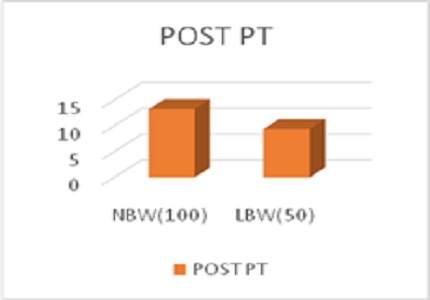Study of hyper bilirubinemia in Low Birth Weight (LBW) and Normal Birth Weight (NBW) babies
Abstract
Introduction: Neonatal hyper bilirubinemia implies significant jaundice usually above 15mg/dl or requiring treatment. About 60-70% of all term newborns develop some degree of jaundice while in LBW babies it goes upto 80%. Jaundice is more prevalent, severe and protracted in low birth weight babies, with more chance of producing neurological injury at lower levels of bilirubin.
Methodology: This study is an attempt to compare the etiology and response to treatment modalities of hyperbilirubinemia in low birth weight and normal birth weight babies. About 150 babies including 50 low birth weight and 100 normal birth weight babies, who were admitted in NICU for neonatal hyperbilirubinemia were selected by purposive sampling and were further analyzed. The variables used for data analysis include number of children requiring phototherapy and exchange transfusion, age at initiation of phototherapy and exchange transfusion, pre phototherapy and pre exchange serum bilirubin, duration of phototherapy and rebound hyperbilirubinemia after phototherapy and exchange transfusion.
Results: The most common etiological factors among low birth weight babies were prematurity, sepsis and ABO incompatibility, among normal birth weight babies were ABO incompatibility, sepsis, Rhin compatibility. In a large proportion of cases, etiology remained idiopathic. Among low birth weight babies Phototherapy was initiated early and at a lower bilirubin level. Duration of phototherapy was more, Rebound hyperbilirubinemia was higher and requirement of exchange transfusion was more.
Conclusion: Hyperbilirubinemia due to incompatibilities prevailed though sepsis contributed a significant fraction among low birth weight babies. Significant hyperbilirubinemia developed earlier and persisted longer requiring prolonged phototherapy, exchange transfusion in low birth weight babies.
Downloads
References
2. Gomella T, Cunningham M. Neonatology 7th Edition. McGraw-Hill Prof Med/Tech; 2013 Jul 21.
3. Dennery PA, Seidman DS, Stevenson DK. Neonatal hyperbilirubinemia. New England Journal of Medicine. 2001 Feb 22;344(8):581-90. [PubMed]
4. Sgro M, Campbell D, Shah V. Incidence and causes of severe neonatal hyperbilirubinemia in Canada. Canadian Medical Association Journal. 2006 Sep 12;175(6):587-90. [PubMed]
5. Narang A, Kumar P, Kumar R. Neonatal jaundice in very low birth weight babies. Indian journal of pediatrics. 2001 Apr 1;68(4):307-9. [PubMed]
6. Watchko JF, Maisels MJ. Jaundice in low birthweight infants: pathobiology and outcome. Archives of Disease in Childhood-Fetal and Neonatal Edition. 2003 Nov 1;88(6):F455-8. [PubMed]
7. Maisels MJ, Watchko JF. Treatment of jaundice in low birthweight infants. Archives of Disease in Childhood-Fetal and Neonatal Edition. 2003 Nov 1;88(6):F459-63.
8. Watchko JF. Kernicterus and the molecular mechanisms of bilirubin-induced CNS injury in newborns. Neuromolecular medicine. 2006 Dec 1;8(4):513-29. [PubMed]
9. Shapiro SM, Bhutani VK, Johnson L. Hyperbilirubinemia and kernicterus. Clinics in perinatology. 2006 Jun 30;33(2):387-410. [PubMed]
10. Kaplan M, Hammerman C. Glucose-6-phosphate dehydrogenase deficiency: a hidden risk for kernicterus. In Seminars in perinatology 2004 Oct 31 (Vol. 28, No. 5, pp. 356-364). WB Saunders.
11. Wilson-Costello D. Risk factors for neurologic impairment among very low-birth-weight infants. InSeminars in pediatric neurology 2001 Jun 30 (Vol. 8, No. 2, pp. 120-126). WB Saunders. [PubMed]
12. Tiker F, Tarcan A, Kilicdag H, Gürakan B. Early onset conjugated hyperbilirubinemia in newborn infants. The Indian Journal of Pediatrics. 2006 May 1;73(5):409-12.
13. Martin TC, Shea M, Alexander D, Bradbury L, Lovell-Roberts L, Francis V. Did exclusive breast-feeding and early discharge lead to excessive bilirubin levels in newborns in Antigua and Barbuda?. The West Indian medical journal. 2002 Jun;51(2):84-8. [PubMed]
14. Bertini G, Dani C, Tronchin M, Rubaltelli FF. Is breastfeeding really favoring early neonatal jaundice?. Pediatrics. 2001 Mar 1;107(3):e41. [PubMed]
15. Maisels MJ, Kring E. Rebound in serum bilirubin level following intensive phototherapy. Archives of pediatrics & adolescent medicine. 2002 Jul 1;156(7):669-72.
16. Abu-Ekteish F, Daoud A, Rimawi H, Kakish K, Abu-Heija A. Neonatal exchange transfusion: a Jordanian experience. Annals of Tropical Paediatrics: International Child Health. 2000 Mar 1;20(1):57-60.

Copyright (c) 2018 Author (s). Published by Siddharth Health Research and Social Welfare Society

This work is licensed under a Creative Commons Attribution 4.0 International License.


 OAI - Open Archives Initiative
OAI - Open Archives Initiative


